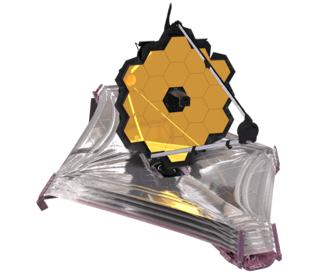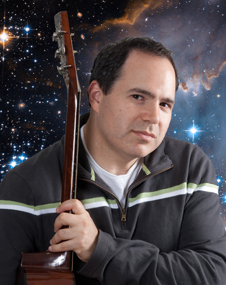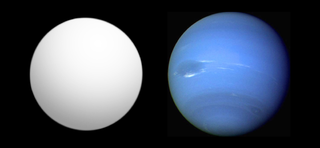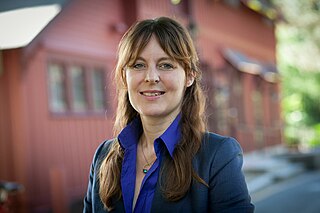
The Hubble Space Telescope is a space telescope that was launched into low Earth orbit in 1990 and remains in operation. It was not the first space telescope, but it is one of the largest and most versatile, renowned as a vital research tool and as a public relations boon for astronomy. The Hubble telescope is named after astronomer Edwin Hubble and is one of NASA's Great Observatories. The Space Telescope Science Institute (STScI) selects Hubble's targets and processes the resulting data, while the Goddard Space Flight Center (GSFC) controls the spacecraft.

The Goddard Space Flight Center (GSFC) is a major NASA space research laboratory located approximately 6.5 miles (10.5 km) northeast of Washington, D.C. in Greenbelt, Maryland, United States. Established on May 1, 1959 as NASA's first space flight center, GSFC employs about 10,000 civil servants and contractors. Named for American rocket propulsion pioneer Robert H. Goddard, it is one of ten major NASA field centers. GSFC is partially within the former Goddard census-designated place; it has a Greenbelt mailing address.

The James Webb Space Telescope (JWST) is a space telescope designed to conduct infrared astronomy. Its high-resolution and high-sensitivity instruments allow it to view objects too old, distant, or faint for the Hubble Space Telescope. This enables investigations across many fields of astronomy and cosmology, such as observation of the first stars and the formation of the first galaxies, and detailed atmospheric characterization of potentially habitable exoplanets.

The Aquarius Dwarf is a dwarf irregular galaxy, first catalogued in 1959 by the DDO survey. It is located within the boundaries of the constellation of Aquarius. It is a member of the Local Group of galaxies, albeit an extremely isolated one; it is one of only a few known Local Group members for which a past close approach to the Milky Way or Andromeda Galaxy can be ruled out, based on its current location and velocity.

John Cromwell Mather is an American astrophysicist, cosmologist and Nobel Prize in Physics laureate for his work on the Cosmic Background Explorer Satellite (COBE) with George Smoot.

Marc Kuchner is an American astrophysicist, a staff member at NASA's Goddard Space Flight Center (GSFC) known for work on images and imaging of disks and exoplanets. Together with Wesley Traub, he invented the band-limited coronagraph, a design for the proposed Terrestrial Planet Finder (TPF) telescope, also to be used on the James Webb Space Telescope (JWST). He is also known for his novel supercomputer models of planet-disk interactions and for developing the ideas of ocean planets, carbon planets, and helium planets. Kuchner appears as an expert commentator in the National Geographic television show "Alien Earths" and frequently answers the "Ask Astro" questions in Astronomy Magazine. He currently serves as the principal investigator of the citizen science websites Disk Detective and Backyard Worlds.

Amy Mainzer is an American astronomer, specializing in astrophysical instrumentation and infrared astronomy. She is the deputy project scientist for the Wide-field Infrared Survey Explorer and the principal investigator for the NEOWISE project to study minor planets and the Near Earth Object Surveyor space telescope mission.

Gravity and Extreme Magnetism Small Explorer mission was a NASA space observatory mission. The main scientific goal of GEMS was to be the first mission to systematically measure the polarization of X-ray sources. GEMS would have provided data to help scientists study the shape of spacetime that has been distorted by a spinning black hole's gravity and the structure and effects of the magnetic fields around neutron stars. It was cancelled by NASA in June 2012 for potential cost overruns due to delays in developing the technology and never moved into the development phase.

An exoplanet is a planet located outside the Solar System. The first evidence of an exoplanet was noted as early as 1917, but was not recognized as such until 2016; no planet discovery has yet come from that evidence. What turned out to be the first detection of an exoplanet was published among a list of possible candidates in 1988, though not confirmed until 2003. The first confirmed detection came in 1992, with the discovery of terrestrial-mass planets orbiting the pulsar PSR B1257+12. The first confirmation of an exoplanet orbiting a main-sequence star was made in 1995, when a giant planet was found in a four-day orbit around the nearby star 51 Pegasi. Some exoplanets have been imaged directly by telescopes, but the vast majority have been detected through indirect methods, such as the transit method and the radial-velocity method. As of 1 May 2024, there are 5,662 confirmed exoplanets in 4,169 planetary systems, with 896 systems having more than one planet. This is a list of the most notable discoveries.

Kepler-11g is an exoplanet discovered in the orbit of the sunlike star Kepler-11 by the Kepler spacecraft, a NASA satellite tasked with searching for terrestrial planets. Kepler-11g is the outermost of the star's six planets. The planet orbits at a distance of nearly half the mean distance between Earth and the Sun. It completes an orbit every 118 days, placing it much further from its star than the system's inner five planets. Its estimated radius is a little over three times that of Earth, i.e. comparable to Neptune's size. Kepler-11g's distance from the inner planets made its confirmation more difficult than that of the inner planets, as scientists had to work to exhaustively disprove all reasonable alternatives before Kepler-11g could be confirmed. The planet's discovery, along with that of the other Kepler-11 planets, was announced on February 2, 2011. According to NASA, the Kepler-11 planets form the flattest and most compact system yet discovered.

Lisa Kaltenegger is an Austrian world-leading astronomer with expertise in the modeling and characterization of exoplanets and the search for life. On July 1, 2014, she was appointed Associate Professor of Astronomy at Cornell University. Previously, she held a joint position at the Max Planck Institute for Astronomy in Heidelberg where she was the Emmy Noether Research Group Leader for the "Super-Earths and Life" group, and at the Center for Astrophysics | Harvard & Smithsonian in Cambridge, MA. She was appointed Lecturer in 2008 at Harvard University and 2011 at University of Heidelberg.

Elisa Victoria Quintana is a scientist working in the field of astronomy and planetary science at NASA Goddard Space Flight Center. Her research focuses the detection and characterization of exoplanets in addition to studying how they form. She is best known for the detection of Kepler 186f, the first Earth-sized planet found in the habitable zone of a star other than the Sun.

The James Webb Space Telescope (JWST) is an international 21st-century space observatory that was launched on 25 December 2021. It is intended to be the premier observatory of the 2020s, combining the largest mirror yet on a near-infrared space telescope with a suite of technologically advanced instruments from around the world.

Amy Simon is an American planetary scientist at NASA's Goddard Space Flight Center, involved in several missions of the Solar System Exploration Program.

Erika Tobiason Hamden is an American astrophysicist and associate professor at the University of Arizona and Steward Observatory. Her research focuses on developing ultraviolet (UV) detector technology, ultraviolet–visible spectroscopy (UV/VIS) instrumentation and spectroscopy, and galaxy evolution. She served as the project scientist and project manager of a UV multi-object spectrograph, FIREBall-2, that is designed to observe the circumgalactic medium (CGM). She is a 2019 TED fellow.
Sangeeta Malhotra is an astrophysicist who studies galaxies, their contents, and their effects on the universe around them. The objects she studies range from our own Milky Way galaxy to some of the earliest and most distant known galaxies in the epoch of cosmic dawn.

Dr Aki Roberge is a research astrophysicist at NASA’s Goddard Space Flight Center, where she is currently the Associate Director for Technology and Strategy. Her research focuses on observational studies of debris disks and planet formation around nearby young stars, with an aim to be able to characterize planets around other stars, perhaps even to find signs of life on them. She is particularly known for her research on the debris disk around Beta Pictoris.

Paul Louis Hertz is an American astrophysicist, and is best known for being the longest-serving Director of the Astrophysics Division at NASA, with a tenure from 2012 to 2022.

Grant Tremblay is an American astrophysicist notable for research on supermassive black holes, science communication, and public advocacy for large space telescopes. He is currently an Astrophysicist at the Harvard-Smithsonian Center for Astrophysics, and was formerly a NASA Einstein Fellow at Yale University, a Fellow at the European Southern Observatory (ESO), and an Astronomer at ESO's Very Large Telescope (VLT).
Jeyhan Sevim Kartaltepe is an American astronomer, Associate Professor and Director of the Rochester Institute of Technology Laboratory for Multiwavelength Astrophysics. Her research considers observational astronomy and galaxy evolution. She is a lead investigator on the Cosmic Evolution Early Release Science Survey and the COSMOS-Webb Survey conducted on the James Webb Space Telescope.



















